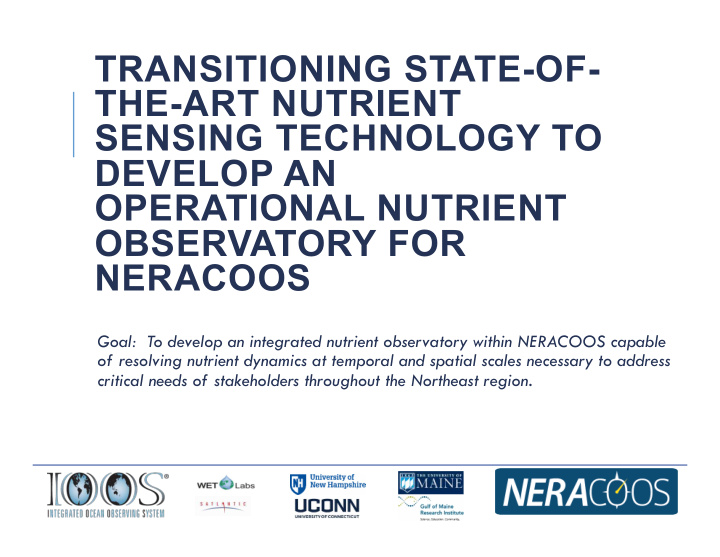



TRANSITIONING STATE-OF- THE-ART NUTRIENT SENSING TECHNOLOGY TO DEVELOP AN OPERATIONAL NUTRIENT OBSERVATORY FOR NERACOOS Goal: To develop an integrated nutrient observatory within NERACOOS capable of resolving nutrient dynamics at temporal and spatial scales necessary to address critical needs of stakeholders throughout the Northeast region.
THE INTEGRATED OCEAN OBSERVING SYSTEM (IOOS) Operated By: Federal Component: Regional Component: Stakeholder driven, science based, policy neutral
ONE SYSTEM MANY USES Integrate Produce Communicate
BUOYS FOR SCIENCE
OCEAN TECHNOLOGY TRANSITION PROJECT The IOOS Ocean Technology Transition project sponsors the transition of emerging marine observing technologies, for which there is an existing operational requirement and a demonstrated commitment to integration and use by the ocean observing community, to operational mode. Transitioning marine observing technology to operations will result in improved ocean, coastal, and Great Lakes observing capabilities that are critical for helping us understand our ocean, coastal, and marine environments and improve environmental intelligence for environmental decision making.
OCEAN TECHNOLOGY TRANSITION PROJECT: FY14 • Integrate the Imaging Flow CytoBot (IFCB) • Operational Ecological Forecasting of Harmful Algal Blooms in the Pacific Northwest using an Environmental Sample Processor • A Real-Time Sensor System for Detecting Freeze-up on Arctic Shelves • Transitioning State-of-the-Art Nutrient Sensing Technology to Develop an Operational Nutrient Observatory for NERACOOS • This system of automated nutrient sensors will deliver high-frequency, quality- controlled nutrient data to scientists, managers, and policy makers to help understand natural and anthropogenic influenced coastal nutrient dynamics throughout the region. • Improving an Ocean Acidification Observing System in Support of Pacific Coast Shell Fish Growers
NERACOOS INTEGRATED NUTRIENT OBSERVATORY 2015-2017* NERACOOS will deploy WET Lab’s PO4 (phosphate), NH4 (ammonium), and Satlantic NO3 (nitrate) sensors on buoys in Great Bay, NH, Narragansett Bay, and in Long Island Sound. Satlantic NO3 (nitrate) sensors will be deployed at multiple depths on a number of buoys in the Gulf of Maine. The red dots show the approximate location of buoys that will carry nutrient sensors. ¡ 10
NERACOOS INTEGRATED NUTRIENT OBSERVATORY 2015 April 2015: Great Bay Deployment, University of New Hampshire May 2015: Great Bay Estuary Stakeholder workshop June 2015: Buoy E and I Deployment, University of Maine July 2015: Long Island Sound Deployment, University of Connecticut September 2015: Buoy M and N Deployment, University of Maine 11
OFFSHORE DEPLOYMENTS IN 2015 June: SUNA nitrates on buoy E (@50m) and I (@50m) Sept: SUNA nitrates on buoy M (@50m, 100m, 150m, 250m) and N (@50m, 100m, 150m, 180m) Ø Sensor acquisition Ø Calibration Ø Preparation Ø Deployment Ø Data availability
OFFSHORE DEPLOYMENTS 2016-2017 SUNA nitrates on buoys E, I, M, N, B, and A
NEARSHORE DEPLOYMENTS Great Bay- 2015 Long Island Sound- 2016 Narragansett Bay- 2017 Ø Sensor acquisition Ø Calibration Ø Preparation Ø Staff training Ø QA/QC development Ø Deployment Ø Data availability
NEARSHORE DEPLOYMENT: GREAT BAY Deployed April 23 with SUNA nitrate and Cycle Phosphate Cycle Ammonium will follow in the summer
DATA ACCESS
STAKEHOLDER ENGAGEMENT AND OUTREACH Ø Stakeholder workshops To develop a clear understanding of stakeholder needs with regard Ø Interviews to nutrient information and to ensure that the design and Ø Listserv operation of the observatory Ø Website delivers data that can be effectively used by key stakeholders. www.neracoos.org/nutrientobservatory
STAKEHO LDER Users How Observatory Results Will be Used Long Island Sound Study Monitor impact of nutrient reduction management practices ENGAGE Complement monthly nutrient monitoring CT Dept. of Energy and Environment MENT RI Dept. of Environmental Characterize water quality conditions Services Improve the boundary conditions for modeling Massachusetts Water Resource AND Authority MA Office of Coastal Zone Help to determine what background nutrients OUTREAC Management WHOI Northeast PSP program Interpreted nutrient fields for predictive HAB models H NH Dept. Environmental Services Monitor permit compliance, support numeric nutrient criteria development, and asses management actions NH Piscataqua Region Estuaries Support research to develop a better understanding Partnership of nutrients ME Dept. of Marine Resources Increase understanding of critical environmental factors ME Coastal Program Assist managers in forecasting future HAB events ME Dept. of Environmental Support assessment of water quality standards Services EPA Region 1 Evaluating the response of coastal waters to nutrient reductions from waste water treatment plants EPA’s Atlantic Ecology Division Incorporation of data into tools for diagnosing and predicting the effects of human activity NOAA’s Northeast Fisheries Understanding the driving force for regional primary Science Center production in the ecosystem Northeast Regional Ocean Nutrient monitoring would become part of the Council Integrated Sentinel Monitoring Program
THANK YOU!
Recommend
More recommend